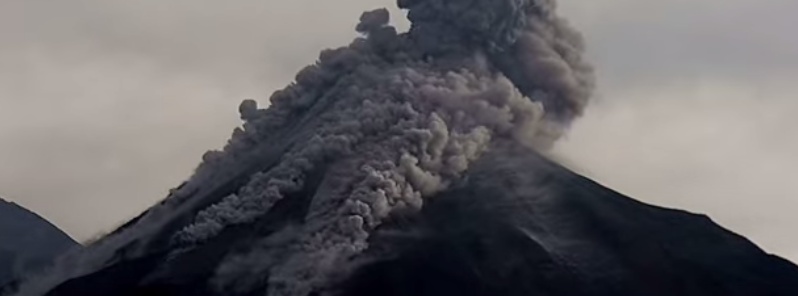Strong eruption of Colima volcano accompanied by pyroclastic flows, Mexico

Mexico's Colima volcano is still very active with an average of 10 – 15 low to moderate explosions per day.
An eruption which occurred at 15:17 UTC on March 27 (08:17 local time) generated ash plume which reached an estimated height of about 3 – 4 km and produced several pyroclastic flows.
They traveled down the western flank of the volcano and one of them reached a distance of about 1.6 km.

Based on satellite images, Mexico City MWO, webcam images, and METAR notices, the Washington VAAC reported that during March 17 – 24 daily ash plumes from Colima rose to altitudes of 4.9 – 8.2 km a.s.l. and drifted 40 – 150 km NNE, NE, ENE, and E.
Geologic summary
The Colima volcanic complex is the most prominent volcanic center of the western Mexican Volcanic Belt. It consists of two southward-younging volcanoes, Nevado de Colima (the 4320 m high point of the complex) on the north and the 3850-m-high historically active Volcán de Colima at the south. A group of cinder cones of late-Pleistocene age is located on the floor of the Colima graben west and east of the Colima complex. Volcán de Colima (also known as Volcán Fuego) is a youthful stratovolcano constructed within a 5-km-wide caldera, breached to the south, that has been the source of large debris avalanches.
Major slope failures have occurred repeatedly from both the Nevado and Colima cones, and have produced a thick apron of debris-avalanche deposits on three sides of the complex. Frequent historical eruptions date back to the 16th century. Occasional major explosive eruptions (most recently in 1913) have destroyed the summit and left a deep, steep-sided crater that was slowly refilled and then overtopped by lava dome growth. (GVP)
Featured image: Eruption of Colima volcano on March 27, 2015. Credit: WebcamsDeMexico

If this volcano would have a serious eruption and put the ash cloud over 12 Kilometers then the Northern Hemisphere would have a chance at cooling. This would be a check on global warming and may actually roll back some of the worst effects of warming.
I have seen a good deal of data that shows a correlation between volcanic activity and solar minima cycles. So every time the sun go’s into shutdown mode the earths volcanic and earth quake activity increases considerably.